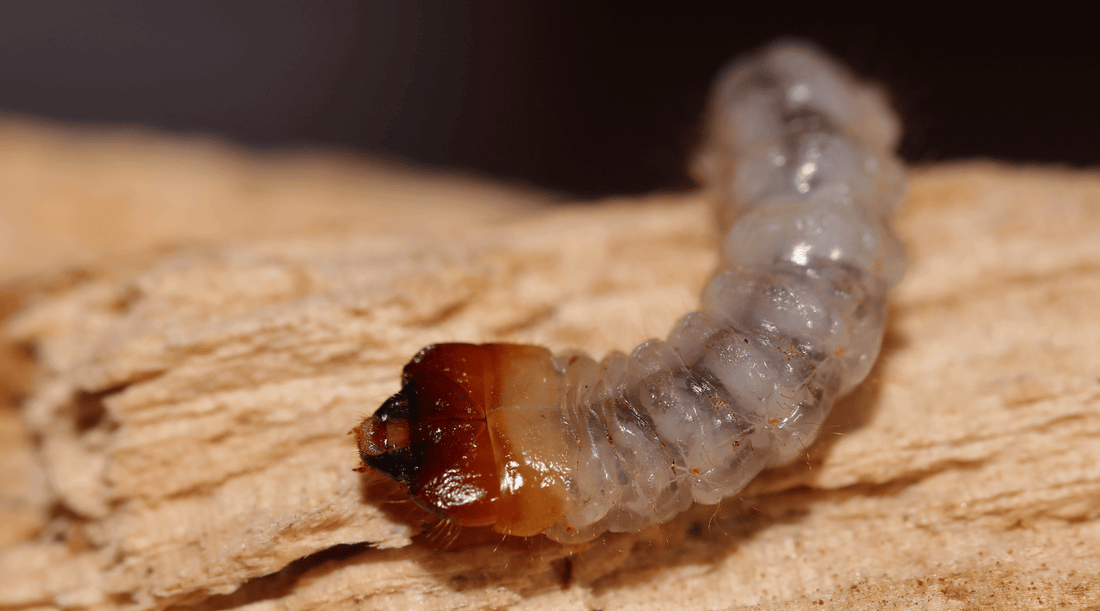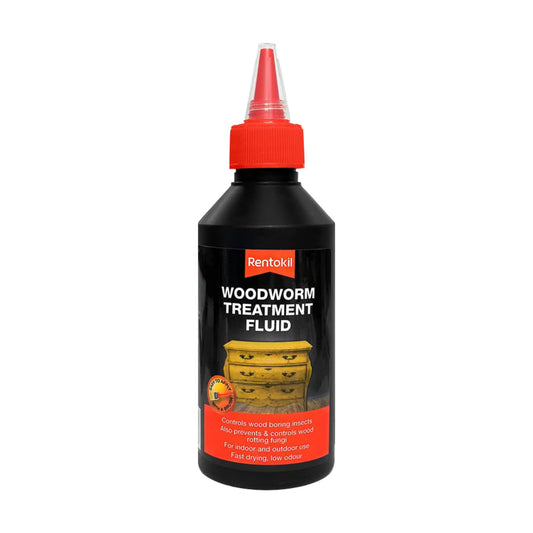
Expert Guide on How to Get Rid of Woodworms Yourself
Share
Woodworms can be a serious problem in homes, causing significant damage to furniture and structural timbers.
There are several steps you can take to identify, manage and control a woodworm infestation. This is before it becomes a larger issue that may require professional help.
This guide on how to get rid of woodworms will help you understand woodworms, recognise the signs of infestation and treat them effectively.
What is Woodworm?
Woodworm is the common name given to the grub (or larvae) of the Common Furniture Beetle (Anobium punctatum). It is also used to refer to other similar wood-boring insects. These grubs are destructive because after hatching on a wooden surface, they love burrowing through it. In doing so they create tiny tunnels and eventually create noticeable holes when they re-emerge as adult beetles.
Woodworm Behaviour
The adult Common Furniture Beetle is a small, brown insect measuring between 3mm and 6mm in length. You are most likely to notice adult beetles from May to September. This is when they emerge leaving behind their characteristic round holes.
The adult beetles prefer to lay their eggs on rough, unpolished wood surfaces. This includes those of wooden furniture, structural timbers and floorboards. The grub, which are typically white or creamy, bore into the wood soon after hatching. This makes it difficult to detect their presence until they emerge around 3 years later as adults.

Woodworm infestations can start in homes through second-hand furniture, tea chests, or wickerwork which can all have woodworms inside. Additionally, adult beetles can fly in from nearby areas including from dead tree branches and nearby homes. Once in your home, they infest floorboards, joists, furniture and even structural timbers like rafters.
Identifying Woodworm Infestations
Recognising woodworms as early as possible is critical for minimising damage done. The following are key things we recommend you look out for that may indicate an ongoing woodworm infestation.
Neat round holes
Look for small, neat round holes in wooden furniture, floorboards, and other wooden surfaces. These holes are typically about 2mm in diameter. Underneath the holes, you might notice tiny piles of fine wood dust which is also known as fass.

Fresh Wood Exposure
Newly formed holes will reveal fresh, clean white wood inside. This indicates active wood-boring activity.
Adult Beetle Sightings
Though rare, you may spot small brown beetles flying near infested wood. This is most common between May and September.
Preventing Woodworm
The good news is that it's perfectly possible to prevent woodworm infestations yourself. It all starts with monitoring your home's wooden materials and ensuring they are always well-protected and dry. Here are several steps we recommend to help reduce the risk of woodworms in your home.
Inspect Furniture Regularly
Before bringing second-hand furniture or any wooden items into your home, you must inspect them carefully. Look out for signs of woodworm including neat round holes starting from 2mm in width as well as wood dust.
Ventilate and Control Moisture
Woodworms thrive in moist, damp environments. This means that it's absolutely essential to keep your home well-ventilated and free from any excess moisture. We recommend that you regularly check that your wooden structures are dry. You should also avoid promoting any conditions which could lead to excess humidity, speeding up wood decay.
Regular Maintenance
Regularly polishing wooden furniture using insecticidal polish can help prevent infestations. Such a polish will prevent new woodworm holes and block off existing holes, killing any grubs or eggs inside.
DIY Woodworm Control Methods
If you discover an infestation in furniture or smaller wooden items, you can attempt treating woodworm yourself using DIY methods.
Woodworm Killer Treatment:
Specialised woodworm killer solutions are available from many hardware stores. Apply the solution to all surfaces including both polished and unpolished. Some woodworm killers may allow you to inject the fluid directly into existing holes using an injector. This will target the grub already inside the wood.
Treating Structural Timbers
For woodworm infestations in structural timbers, such as floor joists or roof beams, DIY treatment may be possible. However, you'll need to take care and follow these steps.
1. Clean the Timbers
Remove any dust, debris, or insulation from the affected areas to ensure the treatment is effective.
2. Cover Electrical and Water Installations
Cover electric cables and water tanks to protect them from the treatment chemicals.
3. Apply Woodworm Fluid
Use the woodworm treatment solution available from pest control shops. Ensure you cover all surfaces thoroughly, including the undersides of floorboards and joists. Follow the product's instructions closely.
4. Reinstall Insulation Carefully
Once treatment is complete, make sure to reinstall any roof or floor insulation carefully to prevent fire hazards.
When to Use Professional Help
While DIY treatment can be great for smaller infestations, woodworms in structural elements can pose a greater risk. In these instances such as in structural timbers, we often recommend consulting professionals.
Woodworm treatment specialists offer detailed surveys and effective solutions for woodworms in structural timbers. We recommend choosing woodworm specialists who are members of the Property Care Association. Many of these companies provide long-term guarantees, which can be valuable if you plan to sell your property in the future.
Other Wood-Boring Insects
Besides the Common Furniture Beetle, other wood-boring insects may cause damage to wooden furniture and parts of your home.
Death Watch Beetle
Targets large, old hardwood beams, often found in historic buildings.
House Longhorn Beetle
Primarily found in North West Surrey, the larvae of this beetle can cause severe damage to softwood timbers.
Powder Post Beetle
This insect requires specific hardwoods containing starch. It is typically found in wooden objects such as antique furniture.
Wood Boring Weevils
Associated with wet rot, these insects often die out once the wet rot issue is addressed.
Final Thoughts
Woodworm infestations can be managed effectively with prompt identification and the right treatment. Regular inspection, maintaining dry conditions, and using preventive polishes can reduce the risk.
For minor cases, DIY solutions such as woodworm killer treatments can be effective. However, when infestation involves structural timbers or is widespread, it is best to consult a professional. This will ensure the issue is handled correctly and safely.
By taking control of your home and staying vigilant for signs of woodworm, you can protect your property and maintain the integrity of your wooden furnishings and structures.

